Prosci Change Triangle (PCT) Model Overview
5 Mins
Updated: October 30, 2025
Published: March 2, 2021

Since it was first released in July 2006, The Prosci Change Triangle Model—commonly known as the PCT Model—has helped countless project teams and change management professionals become more effective by understanding and improving the key aspects of a project’s success. The model describes the four aspects of a successful initiative and how those aspects relate to one another. Using the model and supporting assessment, change practitioners can evaluate project health to identify risks and improve initiative outcomes.
What is the PCT Model?
The PCT Model is a simple but powerful framework that shows the four critical aspects of any successful change effort: success, leadership/sponsorship, project management and change management.
Success is at the center of the model, and the other three aspects are at the corners:
- Success represents the purpose of an initiative or project
- Leadership/sponsorship represents the strategy and direction of an initiative or project
- Project management represents the technical side of an initiative or project
- Change management represents the people side of an initiative or project
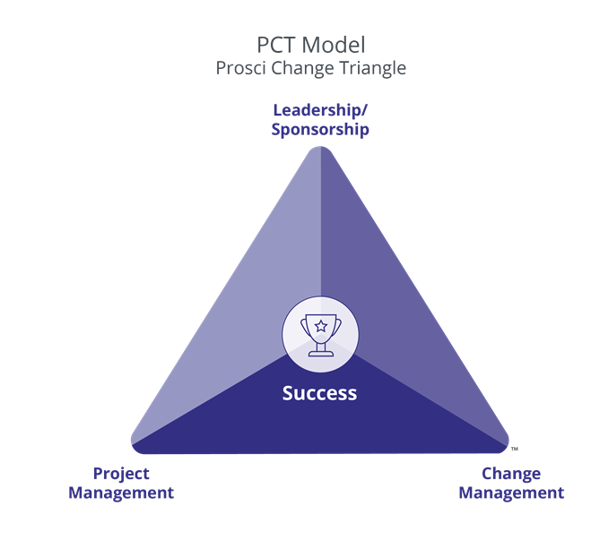
How the PCT Model Works
To understand how the PCT Model works at a basic level, it helps to imagine it as a three-legged stool.
Success at the center
The seat of the stool represents the success at the center of the model. Defining success for your change includes identifying the reason for the change, the project objectives, and the organizational benefits. In the analogy, these are all stacked on the seat of the stool, which is supported by the three legs described below. All three legs must be long enough and strong enough to support achieving the project objectives and desired benefits stacked on the seat.
Leadership/sponsorship leg
The leadership/sponsorship leg represents the direction and guidance for a project or initiative provided by those who have the authority and resources to launch the effort. Leadership/sponsorship is accountable for defining why a change is happening, how it aligns with the direction of the organization, and why it is a priority. This leg also represents the decisions and actions required by leaders to successfully implement and sustain the change, such as providing resources or building a coalition of support with peers.
Project management leg
The project management leg represents the discipline that addresses the technical side of a change by designing, developing and delivering the solution that solves a problem or addresses an opportunity, within the constraints of time, cost and scope. The change process may be sequential, iterative or a hybrid—but in any case, the project management leg must be healthy enough to support the seat.
Change management leg
The change management leg represents the discipline that addresses the people side of the change, enabling people to engage, adopt and use the solution. By understanding what the change means to people’s work and how they navigate or struggle with change, the change management leg supports delivering successful outcomes through the people who must adopt the solution in their day-to-day work.
An Unbalanced PCT Creates A Wobbly Stool
Like a three-legged stool, a project that is missing one of the corner aspects of the Prosci Change Triangle will fail. If one leg is too short, the project will wobble—causing the benefits to "slide off" the seat. Without leadership and direction, a project can struggle to remain a priority and get lost among the numerous projects in the organization. Without a solid project management approach for the technical side, a project may not deliver the necessary solution to meet the need or opportunity. And without a solid change management approach for the people side, employees may never embrace, adopt and use the solution—resulting in diminished outcomes.
How the PCT Model Corners Interrelate
In addition to the corners and center of the PCT Model—the four aspects of the PCT—it is critical to understand the sides of the triangle that connect the corners. These sides represent how the three corner aspects connect to and work with the other disciplines during a change.
The leadership/sponsorship aspect plays a role at two levels. At the organizational level, leaders are responsible for creating the vision and strategy for where the organization is heading. At a project level, leaders must show how a project or initiative aligns with and supports that organizational direction.
For any change to be successful, leadership/sponsorship must participate in both decisions (the connection with project management) and actions (the connection with change management).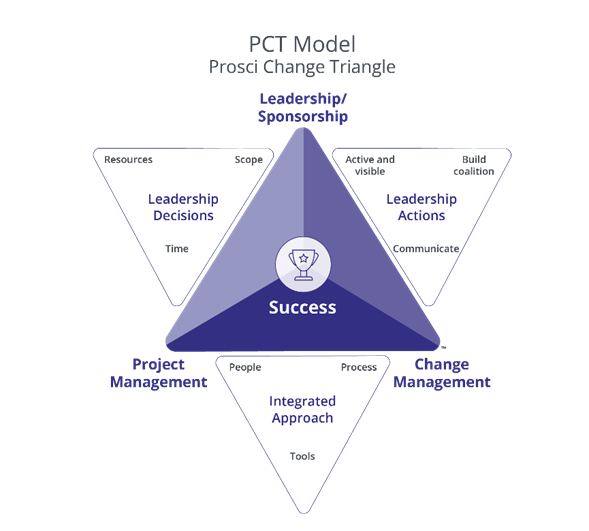
Leadership decisions
The Leadership Decisions side of the PCT Model represents the relationship between leadership/sponsorship and project management. This connects the decisions executives make to the project, scope, schedule and resources for the change. Note that leaders and sponsors are typically comfortable with making such decisions because they already view decision-making as part of their job role.
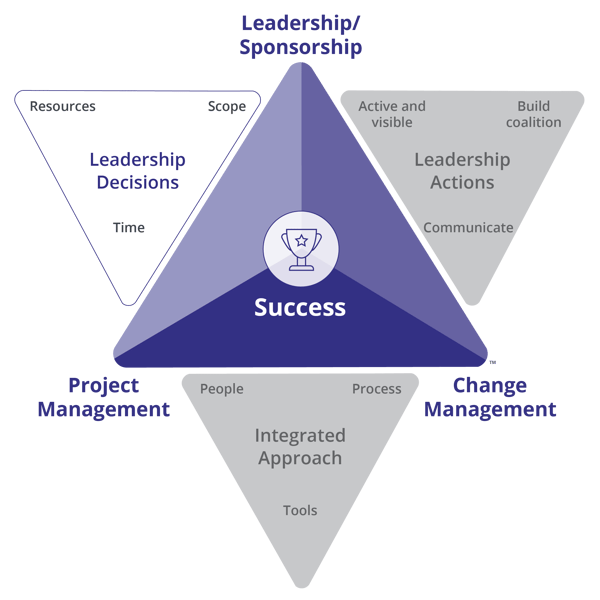
Leadership actions
Leadership Actions highlight the relationship between the leadership/sponsorship and change management aspects of the model. This involves ensuring that leaders/sponsors perform the three critical roles required for project success. Emerging from years of research on the role of sponsorship in driving change success, Prosci refers to these the ABC’s of Sponsorship:
- Actively and visibly participate in the project
- Build a coalition of support
- Communicate directly with employees
When change management is new to a leader or sponsor, or they need clarification about their role, it is the change practitioner’s job to provide coaching and support to enable the leader to fulfill their role successfully.
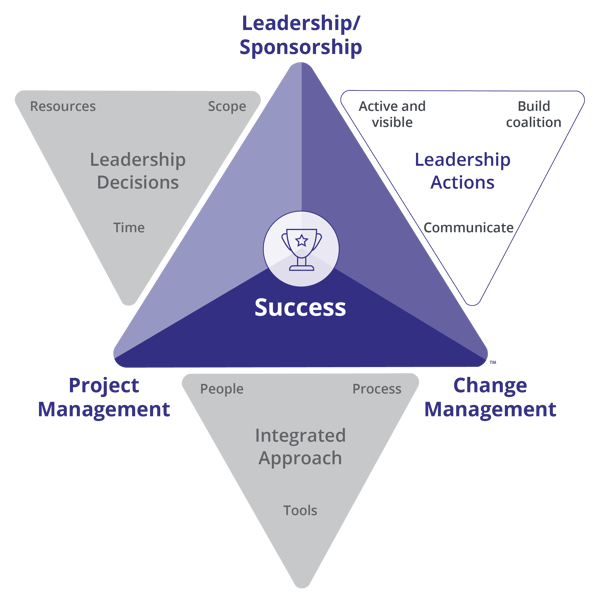
Integrated approach
The integrated approach refers to the relationship between project management and change management in the PCT Model. This includes three dimensions of integration: people, process and tools.
People describes who does the work, process describes how the work gets done, and tools describes what we use to do the work. Note the deliberate placement of “people” on the project management side to remind project management teams of the importance of integrating with the people side of a change. Similarly, “process” is located on the change management side to highlight the importance of project management activities to change managers. Initiatives that execute project management and change management through an integrated approach are more successful.
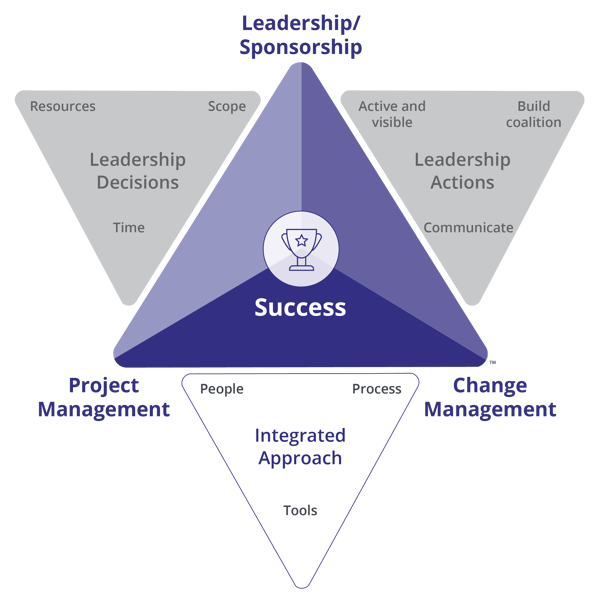
Apply the PCT Model With PCT Assessment
In addition to understanding the implications of the PCT Model as a framework, teams can apply Prosci’s PCT Assessment to position the project for success by gauging project health across the four critical aspects of the model at a point in time.
The PCT Assessment guides the user through three key activities in logical order: assessment, analysis, and actions to address. The assessment enables change practitioners to identify and address specific risks or weaknesses in the initiative. If the results reveal that a project is weak in any of the four PCT Model aspects, the project will struggle or fail. However, leveraging the assessment outputs and resulting analysis enables the team to develop targeted actions to address such weaknesses. And when applied properly, the PCT Assessment scores are a strong indicator of the potential for a successful implementation.
Any qualified member of the change management team, project team, senior leadership or key business leader from the impacted groups can conduct a PCT Assessment. What matters is that you conduct an initial PCT Assessment early in the lifecycle of the project to establish a baseline. Conducting the assessment again at key points during the project reveals whether scores are improving over time and where attention is needed. After each assessment, the change teams should create a set of action plans to improve performance where scores are low.
Value of the PCT Model
The PCT Model and the PCT Assessment offer value to project and change teams in several ways:
- A shared understanding of the PCT Model provides project teams with common language and context for the four aspects of successful change.
- The PCT Model positions change management’s unique contribution relative to project management and leadership/sponsorship at a glance, as well as in depth.
- Applying the model and PCT Assessment enables teams to evaluate the health of an initiative at a point in time to identify key risks. Through repeated application over the lifecycle of the initiative, the model and assessment enable teams to evaluate progress and improve initiative health with informed interventions.
- Leveraging the model and assessment enables teams to identify organizational competencies and gaps by evaluating assessment results from multiple projects.
Improve Project Outcomes
Healthy projects have four aspects in common: a clear and shared definition of success, guidance and direction from leaders, a well-delivered technical solution, and adoption of that solution by impacted people. The Prosci Change Triangle captures these four aspects and makes their interrelationships clear. The PCT Assessment extends the model’s value by providing teams with a diagnostic tool for evaluating project and initiative health, identifying risks, and enabling actions. Change practitioners, project managers and leaders can use this simple yet powerful model to improve outcomes on projects and initiatives.




